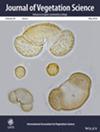Effects of a Recent Volcanic Eruption on Facilitation Networks in Shrublands of Northwest Patagonia, Argentina
Abstract
Aims
This study examined the impact of tephra fall on microsite conditions and plant–plant interaction networks, as well as the extent to which different nurse species groups with varying traits (evergreen and deciduous) influence the outcomes of microsite conditions and facilitated species composition.
Location
Four shrublands located in Nahuel Huapi National Park, in Northern Patagonia, Argentina (41°11′55.34″ S, 71°19′43.07″ W).
Methods
We selected 10 woody species as nurse species: five evergreens and five deciduous species. We recorded the microsite conditions, species composition and total cover below nurse species and in open spaces during three consecutive years: two previous to tephra fall that differed in their rainfall and one after tephra fall. We determined the facilitated species with the relative interaction intensity in plants (RII) index, constructed facilitation networks and analysed the species composition below nurses and in open spaces. We experimentally determined the tephra effect on the emergence and survival of two emblematic tree species, the native Austrocedrus chilensis and the exotic conifer Pseudotsuga menziesii.
Results
Our study detected significant changes in microsite conditions, species composition and relative abundance due to tephra fall. The characteristics of microsites were changed by tephra fall, homogenising the studied shrubland and consequently affecting the plant–plant interaction. The experimental results demonstrated that the factor influencing the emergence of the coniferous trees under investigation was the thickness of the tephra, rather than the seedling species or type of tephra.
Conclusions
Our findings provide insights into the patterns and mechanisms of facilitation networks in Patagonian shrublands. We found that networks were robust and, despite some decreases in facilitation interactions, the generalist network structure was resilient to microsite changes due to the tephra and contributed to community maintenance. Although tephra fall is a natural disturbance in the region, it is necessary to deepen the implications for the exotic pine invasion dynamics in future research.


 求助内容:
求助内容: 应助结果提醒方式:
应助结果提醒方式:


